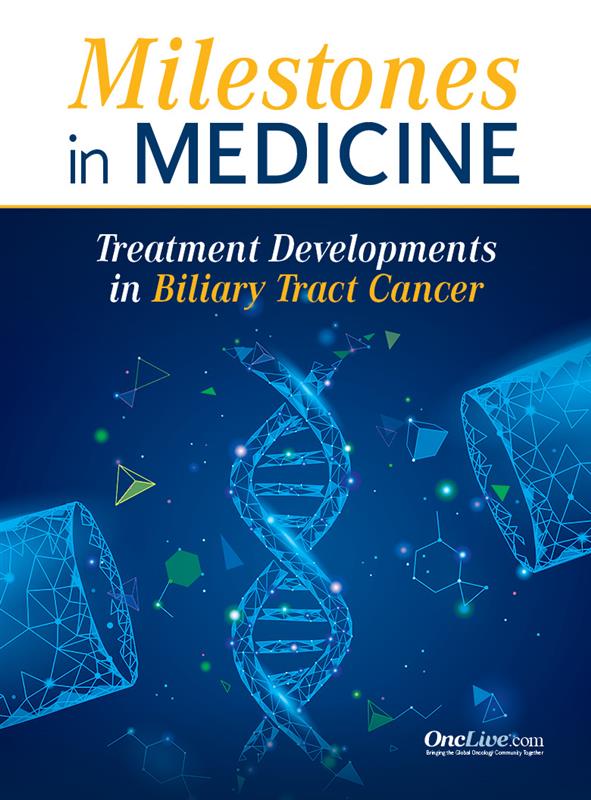Durvalumab/Chemo Combination and Other Novel Treatments Arise in Biliary Tract Cancers
Chemoimmunotherapy combinations, along with therapies targeting IDH1, FGFR2, and HER2 mutations, are ushering in a new era of treatment for biliary tract cancers.
Do-Youn Oh, MD, PhD

Chemoimmunotherapy combinations, along with therapies targeting IDH1, FGFR2, and HER2 mutations, are ushering in a new era of treatment for biliary tract cancers, according to Do-Youn Oh, MD, PhD.
The longtime standard of care (SOC) for this collection of diseases was gemcitabine plus cisplatin, after the chemotherapy combination demonstrated efficacy in the phase 3 ABC-02 trial (NCT00262769). A new combination, durvalumab (Imfinzi) plus gemcitabine and cisplatin, has emerged, displaying a 24-month overall survival (OS) rate of 24.9% in the phase 3 TOPAZ-1 trial (NCT03875235).1 Results from the trial led to the FDA approval of durvalumab in combination with gemcitabine and cisplatin in adult patients with locally advanced or metastatic biliary tract cancers on September 2, 2022.2
“The main message of the TOPAZ-1 study is that the combination of immunotherapy, in this case, durvalumab, a PD-L1 inhibitor, on top of the current SOC of gemcitabine/cisplatin cytotoxic chemotherapy, improved the OS compared to the cytotoxic [chemotherapy regimen alone],” Oh said.
In an interview with OncLive®, Oh discussed how the incidence of biliary tract cancers differs around the world, why the subdivisions of this rare disease are important to be aware of when designing clinical trials, and how the TOPAZ-1 regimen and other agents, such as ivosidenib (Tibsovo), have set the stage for advances in immunotherapy and targeted therapy for this population. Oh is a professor in the Department of Medical Oncology at the Seoul National University College of Medicine.
OncLive®: Could you speak to the geographic diversity of risk factors for biliary tract cancer and the resulting impact on the incidence of this disease around the world?
Oh: From a global point of view, the incidence of biliary tract cancer is relatively low compared with other solid tumor types such as lung cancer, breast cancer, gastric cancer, [and others]. However, the incidence of biliary tract cancer is higher in Asian countries compared with the Western countries. The incidence is quite high in southern China, some areas of Thailand, and South Korea. For example, in South Korea, the annual incidence of new cases of biliary tract cancer is 10 to 12 patients per 100,000 [people in the] population, which is quite high compared with the incidence in the United States, Europe, and other countries.
What is the best path toward drug development, given some historical challenges in this area?
The prognosis of biliary tract cancer, especially in advanced stages, is not good. The main reason is that it’s a relatively rare cancer, so [not much research is] presented to sponsoring companies in the drug development field. That’s the main reason [why we have not developed] many good treatment regimens.
Based on [findings from] the ABC-02 trial, [which were presented in 2010,] the global first-line SOC for advanced-stage biliary tract cancer is the combination of gemcitabine and cisplatin. That regimen has not been changed in over a decade, because we hadn’t had a successful phase 3 global study to [improve upon the]gemcitabine and cisplatin combination [until TOPAZ-1].
What is the optimal design for clinical trials for patients with biliary tract cancer?
Biliary tract cancer is a heterogeneous group [of diseases that are defined] based on the primary location, including intrahepatic cholangiocarcinoma, extrahepatic cholangiocarcinoma, and gallbladder cancer.
According to the primary site of origin [of the disease], the molecular profiles of tumors are a bit different [from each other]. It’s always challenging when we design clinical trials [to decide] whether we include all types of biliary tract cancer together, or exclude [certain types].
You presented the primary findings of the TOPAZ-1 trial at the 2021 ASCO Gastrointestinal (GI) Cancers Symposium. Since then, we’ve seen subgroup analyses presented at the 2022 ESMO World Congress on GI Cancer, showing a benefit with the immunotherapy regimen regardless of primary tumor location. How do you see these results affecting precision medicine and molecular profiling in this population?
At the original primary analysis, the OS benefit [elicited by] adding durvalumab to gemcitabine and cisplatin had an HR of 0.80. The benefit of durvalumab was observed regardless of the primary tumor origin. [Patients with] intrahepatic cholangiocarcinoma, extrahepatic cholangiocarcinoma, and gallbladder cancer all benefitted, even though there were some differences. For example, in gallbladder cancer, the HR was a bit high compared with the other 2 tumor types. In the TOPAZ-1 study, we did not include ampullar of vater cancer, just the 3 other subtypes. Now, we can say that when adding durvalumab to gemcitabine/cisplatin chemotherapy, all the patients [with intrahepatic cholangiocarcinoma, extrahepatic cholangiocarcinoma, or gallbladder cancer] benefit, regardless of primary tumor origin.
After the primary analysis, we did a longer follow-up of the TOPAZ-1 population. At the 2022 ESMO Congress, we reported the updated efficacy analysis. [In total,] 6.5 months of follow-up were added from the primary analysis. The median follow-up duration was 23.4 months [for the durvalumab arm].
With the longer follow-up, the HR for OS was 0.76. With this longer follow-up, we can say that the durvalumab benefit is consistently and clinically meaningfully observed in patients with biliary tract cancer, compared with gemcitabine/cisplatin alone.
Could you speak to the role that targeted therapy has taken on in recent years in biliary tract cancer?
[Beyond the] success with immunotherapy in the TOPAZ-1 trial, recently, we have seen some success with targeted therapy in biliary tract cancer, which is good news.
The first success of targeted therapy in biliary tract cancer has been the targeting of the IDH1 mutation. A portion of patients with biliary tract cancer patient have IDH1/2 mutations. Now, we have a drug targeting mutant IDH1. We have positive data with ivosidenib in the second- and third-line setting for biliary tract cancer. We have seen success targeting the IDH1 mutation.
Another important success is targeting the FGFR2 fusion or translocation. Several FGFR inhibitors have already been approved, such as pemigatinib [Pemazyre] and infigratinib [Truseltiq]. Those FGFR fusions or rearrangements are interesting and important therapeutic targets.
Nowadays, I’m happy to see the progress of ongoing clinical trials using interesting targeted agents in the biliary tract cancer field. One example is targeting HER2 [mutations]. Like breast cancer or gastric cancer, some patients with biliary tract cancer harbor HER2 gene amplification and sometimes the HER2 mutation and protein expression. Targeting HER2 is another promising therapeutic strategy in biliary tract cancer.
What does the FDA approval of durvalumab in combination with gemcitabine and cisplatin mean for patients and providers?
Based on the success of the TOPAZ-1 trial, the [National Comprehensive Cancer Network] guidelines adopted the durvalumab plus gemcitabine/cisplatin combination regimen as the category 1 preferred regimen in the first line for advanced biliary tract cancer. On September 2, the FDA approved durvalumab plus gemcitabine and cisplatin in biliary tract cancers.
This is quite good news for our biliary tract cancer patients. So far, the first-line SOC for advanced biliary tract cancer has been gemcitabine and cisplatin. Globally, that has been the SOC for over a decade, without changing. But at this time, we can say that the new SOC in the first line for advanced biliary tract cancer is durvalumab plus gemcitabine and cisplatin.
I expect other regulatory authorities besides the FDA might also approve this durvalumab [regimen] in biliary tract cancer. I hope to see those approvals soon.
What research in biliary tract cancer is ongoing at Seoul National University?
At our site, we have many clinical trials targeting biliary tract cancer, and new compounds [are being investigated in] phase 1 studies. Now, I’m exploring the role of immunotherapy in the first-line setting, [plus] the second- and later-line settings, in combination with other targeted agents. A new and interesting targeted agent has been also tested in a formal phase 1 study, which included a biliary tract cancer cohort.
References
- Oh D, He AR, Qin S, et al. Durvalumab plus gemcitabine and cisplatin in advanced biliary tract cancer. NEJM Evid. 2022;1(8). doi:10.1056/EVIDoa2200015
- FDA approves durvalumab for locally advanced or metastatic biliary tract cancer. News release. FDA. September 2, 2022. Accessed September 28, 2022. https://bit.ly/3TOU798




